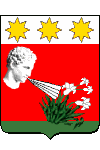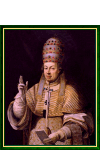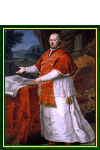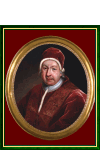Pius VI
Pope from 1775 to 1799
Pronunciation:

Giannangelo, Count Braschi, was born on December 25, 1717 in Cesena, Romagna, the eldest son of a noble family.
After studying civil and canon law at the University of Ferrara, he became secretary to Cardinal Tommaso Ruffo, then in 1753 private secretary to Pope Benedict XIV.
It was not until 1758 that he was ordained a priest. On April 26, 1773, he was elevated to the dignity of Cardinal-Priest of Sant'Onofrio.
On February 15, 1775, Giannangelo Braschi was elected pope, taking the name Pius VI (in Latin Pius VI, in Italian Pio VI).
In reaction to the ecclesiastical reforms of the Austrian Emperor Joseph II, who secularized many monasteries and forbade bishops to apply to Rome for canonical dispensations, Pius VI went to Vienna in 1782, but to no avail.
Faced with the French Revolution, he strongly condemned the Civil Constitution of the Clergy in 1791, and was forced to accept the annexation of Avignon and the Comtat Venaissin the same year. During the Italian campaign, the armistice of Bologna in 1796 granted him a respite, but the Treaty of Tolentino in 1797 forced him to cede territory (legations of Romagna, Bologna and Ferrara).
After Alexandre Berthier's troops entered Rome on February 10, 1798, the people proclaimed the "Roman Republic". Pius VI was immediately forced by the French Republic to renounce his temporal power and leave the Eternal City, which he did on the night of February 19 to 20, 1798.
Taking refuge in Siena and then Florence, he was captured by French troops and taken prisoner. He was successively taken to Bologna, Parma, Turin, then Grenoble, Briançon, and finally Valence (in the Drôme département).
It was in Valence that he was imprisoned by the French Republic and died, exhausted, on August 29, 1799, aged 82.
Initially buried in the Valence cemetery, Pius VI's body was repatriated to Rome in 1802 for burial in St. Peter's Basilica . A few years later, at the request of the people of Valence, his heart and entrails were returned to the cathedral of Saint-Apollinaire de Valence .
"Pope Pius VI" by Pompeo Girolamo Batoni (Lucca 1708 - Rome 1787).

Philately: In 1958, the Vatican Post Office (Poste Vaticane) issued a 35 lire stamp bearing the effigy of Pope Pius VI, as part of a tribute to the sculptor Antonio Canova.
Other portraits

"Pope Pius VI in 1775". Anonymous painter, late eighteenth century.

"Pope Pius VI". Anonymous painter, late eighteenth century.

"Pope Pius VI". Anonymous painter, late eighteenth century.